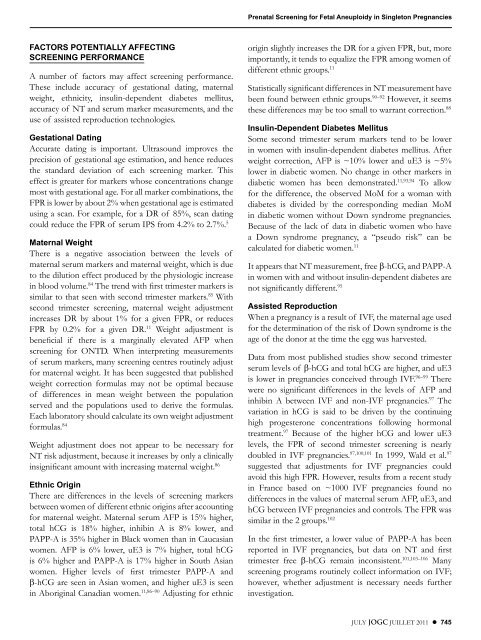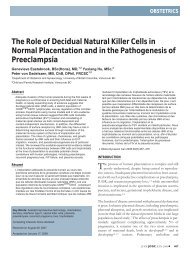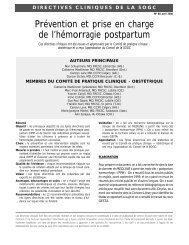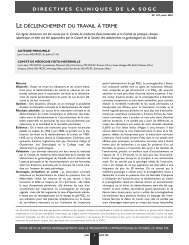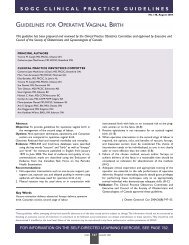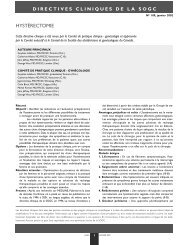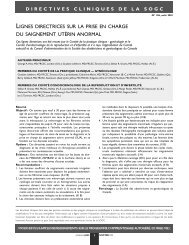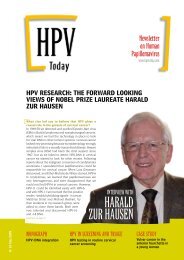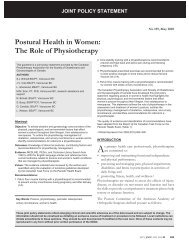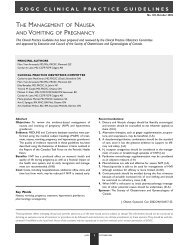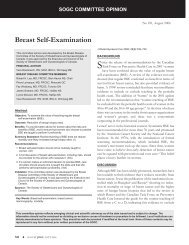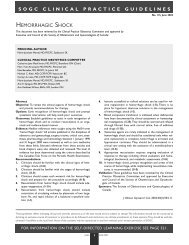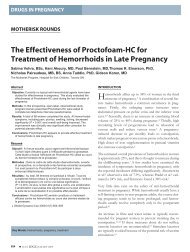Prenatal Screening for Fetal Aneuploidy in Singleton ... - SOGC
Prenatal Screening for Fetal Aneuploidy in Singleton ... - SOGC
Prenatal Screening for Fetal Aneuploidy in Singleton ... - SOGC
You also want an ePaper? Increase the reach of your titles
YUMPU automatically turns print PDFs into web optimized ePapers that Google loves.
FACTORS POTENTIALLY AFFECTING<br />
SCREENING PERFORMANCE<br />
A number of factors may affect screen<strong>in</strong>g per<strong>for</strong>mance.<br />
These <strong>in</strong>clude accuracy of gestational dat<strong>in</strong>g, maternal<br />
weight, ethnicity, <strong>in</strong>sul<strong>in</strong>-dependent diabetes mellitus,<br />
accuracy of NT and serum marker measurements, and the<br />
use of assisted reproduction technologies.<br />
Gestational Dat<strong>in</strong>g<br />
Accurate dat<strong>in</strong>g is important. Ultrasound improves the<br />
precision of gestational age estimation, and hence reduces<br />
the standard deviation of each screen<strong>in</strong>g marker. This<br />
effect is greater <strong>for</strong> markers whose concentrations change<br />
most with gestational age. For all marker comb<strong>in</strong>ations, the<br />
FPR is lower by about 2% when gestational age is estimated<br />
us<strong>in</strong>g a scan. For example, <strong>for</strong> a DR of 85%, scan dat<strong>in</strong>g<br />
could reduce the FPR of serum IPS from 4.2% to 2.7%. 5<br />
Maternal Weight<br />
There is a negative association between the levels of<br />
maternal serum markers and maternal weight, which is due<br />
to the dilution effect produced by the physiologic <strong>in</strong>crease<br />
<strong>in</strong> blood volume. 84 The trend with first trimester markers is<br />
similar to that seen with second trimester markers. 85 With<br />
second trimester screen<strong>in</strong>g, maternal weight adjustment<br />
<strong>in</strong>creases DR by about 1% <strong>for</strong> a given FPR, or reduces<br />
FPR by 0.2% <strong>for</strong> a given DR. 11 Weight adjustment is<br />
beneficial if there is a marg<strong>in</strong>ally elevated AFP when<br />
screen<strong>in</strong>g <strong>for</strong> ONTD. When <strong>in</strong>terpret<strong>in</strong>g measurements<br />
of serum markers, many screen<strong>in</strong>g centres rout<strong>in</strong>ely adjust<br />
<strong>for</strong> maternal weight. It has been suggested that published<br />
weight correction <strong>for</strong>mulas may not be optimal because<br />
of differences <strong>in</strong> mean weight between the population<br />
served and the populations used to derive the <strong>for</strong>mulas.<br />
Each laboratory should calculate its own weight adjustment<br />
<strong>for</strong>mulas. 84<br />
Weight adjustment does not appear to be necessary <strong>for</strong><br />
NT risk adjustment, because it <strong>in</strong>creases by only a cl<strong>in</strong>ically<br />
<strong>in</strong>significant amount with <strong>in</strong>creas<strong>in</strong>g maternal weight. 86<br />
Ethnic Orig<strong>in</strong><br />
There are differences <strong>in</strong> the levels of screen<strong>in</strong>g markers<br />
between women of different ethnic orig<strong>in</strong>s after account<strong>in</strong>g<br />
<strong>for</strong> maternal weight. Maternal serum AFP is 15% higher,<br />
total hCG is 18% higher, <strong>in</strong>hib<strong>in</strong> A is 8% lower, and<br />
PAPP-A is 35% higher <strong>in</strong> Black women than <strong>in</strong> Caucasian<br />
women. AFP is 6% lower, uE3 is 7% higher, total hCG<br />
is 6% higher and PAPP-A is 17% higher <strong>in</strong> South Asian<br />
women. Higher levels of first trimester PAPP-A and<br />
β-hCG are seen <strong>in</strong> Asian women, and higher uE3 is seen<br />
<strong>in</strong> Aborig<strong>in</strong>al Canadian women. 11,86–90 Adjust<strong>in</strong>g <strong>for</strong> ethnic<br />
<strong>Prenatal</strong> <strong>Screen<strong>in</strong>g</strong> <strong>for</strong> <strong>Fetal</strong> <strong>Aneuploidy</strong> <strong>in</strong> S<strong>in</strong>gleton Pregnancies<br />
orig<strong>in</strong> slightly <strong>in</strong>creases the DR <strong>for</strong> a given FPR, but, more<br />
importantly, it tends to equalize the FPR among women of<br />
different ethnic groups. 11<br />
Statistically significant differences <strong>in</strong> NT measurement have<br />
been found between ethnic groups. 90–92 However, it seems<br />
these differences may be too small to warrant correction. 88<br />
Insul<strong>in</strong>-Dependent Diabetes Mellitus<br />
Some second trimester serum markers tend to be lower<br />
<strong>in</strong> women with <strong>in</strong>sul<strong>in</strong>-dependent diabetes mellitus. After<br />
weight correction, AFP is ~10% lower and uE3 is ~5%<br />
lower <strong>in</strong> diabetic women. No change <strong>in</strong> other markers <strong>in</strong><br />
diabetic women has been demonstrated. 11,93,94 To allow<br />
<strong>for</strong> the difference, the observed MoM <strong>for</strong> a woman with<br />
diabetes is divided by the correspond<strong>in</strong>g median MoM<br />
<strong>in</strong> diabetic women without Down syndrome pregnancies.<br />
Because of the lack of data <strong>in</strong> diabetic women who have<br />
a Down syndrome pregnancy, a “pseudo risk” can be<br />
calculated <strong>for</strong> diabetic women. 11<br />
It appears that NT measurement, free β-hCG, and PAPP-A<br />
<strong>in</strong> women with and without <strong>in</strong>sul<strong>in</strong>-dependent diabetes are<br />
not significantly different. 95<br />
Assisted Reproduction<br />
When a pregnancy is a result of IVF, the maternal age used<br />
<strong>for</strong> the determ<strong>in</strong>ation of the risk of Down syndrome is the<br />
age of the donor at the time the egg was harvested.<br />
Data from most published studies show second trimester<br />
serum levels of β-hCG and total hCG are higher, and uE3<br />
is lower <strong>in</strong> pregnancies conceived through IVF. 96–99 There<br />
were no significant differences <strong>in</strong> the levels of AFP and<br />
<strong>in</strong>hib<strong>in</strong> A between IVF and non-IVF pregnancies. 97 The<br />
variation <strong>in</strong> hCG is said to be driven by the cont<strong>in</strong>u<strong>in</strong>g<br />
high progesterone concentrations follow<strong>in</strong>g hormonal<br />
treatment. 97 Because of the higher hCG and lower uE3<br />
levels, the FPR of second trimester screen<strong>in</strong>g is nearly<br />
doubled <strong>in</strong> IVF pregnancies. 97,100,101 In 1999, Wald et al. 97<br />
suggested that adjustments <strong>for</strong> IVF pregnancies could<br />
avoid this high FPR. However, results from a recent study<br />
<strong>in</strong> France based on ~1000 IVF pregnancies found no<br />
differences <strong>in</strong> the values of maternal serum AFP, uE3, and<br />
hCG between IVF pregnancies and controls. The FPR was<br />
similar <strong>in</strong> the 2 groups. 102<br />
In the first trimester, a lower value of PAPP-A has been<br />
reported <strong>in</strong> IVF pregnancies, but data on NT and first<br />
trimester free β-hCG rema<strong>in</strong> <strong>in</strong>consistent. 101,103–106 Many<br />
screen<strong>in</strong>g programs rout<strong>in</strong>ely collect <strong>in</strong><strong>for</strong>mation on IVF;<br />
however, whether adjustment is necessary needs further<br />
<strong>in</strong>vestigation.<br />
JULY JOGC JUILLET 2011 l 745


